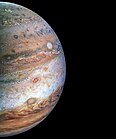
Juno (spacecraft)
Juno is a NASA space probe orbiting the planet Jupiter. It was built by Lockheed Martin and is operated by NASA's Jet Propulsion Laboratory. The spacecraft was launched from Cape Canaveral Air Force Station on August 5, 2011 UTC, as part of the New Frontiers program.[6] Juno entered a polar orbit of Jupiter on July 5, 2016, UTC,[4][7] to begin a scientific investigation of the planet.[8] After completing its mission, Juno was originally planned to be intentionally deorbited into Jupiter's atmosphere,[8] but has since been approved to continue orbiting until contact is lost with the spacecraft.
Names
New Frontiers 2
Jupiter orbiter
37773
Planned: 7 years
Elapsed: 12 years, 10 months, 26 days
Cruise: 4 years, 10 months, 29 days
Science phase: 2 years, 11 months and 2 days (in progress) (extended until September 2025)
3,625 kg (7,992 lb) [1]
1,593 kg (3,512 lb) [2]
20.1 × 4.6 m (66 × 15 ft) [2]
14 kW at Earth,[2] 435 W at Jupiter [1]
2 × 55-ampere hour lithium-ion batteries[2]
August 5, 2011, 16:25:00 UTC
Atlas V 551 (AV-029)
October 9, 2013
559 km (347 mi)
July 5, 2016, [3]
7 years, 11 months, 27 days ago
4,200 km (2,600 mi) altitude
75,600 km (47,000 mi) radius
8.1×106 km (5.0×106 mi)
90° (polar orbit)
Juno's mission is to measure Jupiter's composition, gravitational field, magnetic field, and polar magnetosphere. It will also search for clues about how the planet formed, including whether it has a rocky core, the amount of water present within the deep atmosphere, mass distribution, and its deep winds, which can reach speeds up to 620 km/h (390 mph).[9]
Juno is the second spacecraft to orbit Jupiter, after the nuclear powered Galileo orbiter, which orbited from 1995 to 2003.[8] Unlike all earlier spacecraft sent to the outer planets,[8] Juno is powered by solar panels, commonly used by satellites orbiting Earth and working in the inner Solar System, whereas radioisotope thermoelectric generators are commonly used for missions to the outer Solar System and beyond. For Juno, however, the three largest solar panel wings ever deployed on a planetary probe (at the time of launching) play an integral role in stabilizing the spacecraft as well as generating power.[10]
Scientific results[edit]
Among early results, Juno gathered information about Jovian lightning that revised earlier theories.[116] Juno provided the first views of Jupiter's north pole, as well as providing insight about Jupiter's aurorae, magnetic field, and atmosphere.[117]
In 2021, analysis of the frequency of interplanetary dust impacts (primarily on the backs of the solar panels), as Juno passed between Earth and the asteroid belt, indicated that this dust, which causes the Zodiacal light, comes from Mars, rather than from comets or asteroids that come from the outer solar system, as was previously thought.[118]
Juno made many discoveries that are challenging existing theories about Jupiter's formation. When Juno flew over the poles of Jupiter it imaged clusters of stable cyclones that exist at the poles.[119] It found that the magnetosphere of Jupiter is uneven and chaotic. Using its Microwave Radiometer, Juno found that the red and white bands that can be seen on Jupiter extend hundreds of kilometers into the Jovian atmosphere, yet the interior of Jupiter is not evenly mixed. This has resulted in the theory that Jupiter does not have a solid core as previously thought, but a "fuzzy" core made of pieces of rock and metallic hydrogen. This peculiar core may be a result of a collision that happened early on in Jupiter's formation.[120]
In April 2020, Juno detected a meteor impact on Jupiter, with estimated mass of 250-5000 kg.[121]
Results from Juno on storms suggests that they are far taller than expected, with some extending 60 miles (100 kilometers) below the cloud tops and others, including the Great Red Spot, extending over 200 miles (350 kilometers). With Juno traveling low over Jupiter's cloud deck at about 130,000 mph (209,000 kph) Juno scientists were able to measure velocity changes as small 0.01 millimeter per second using a NASA's Deep Space Network tracking antenna, from a distance of more than 400 million miles (650 million kilometers). This enabled the team to constrain the depth of the Great Red Spot to about 300 miles (500 kilometers) below the cloud tops. The new results show that the cyclones are warmer on top, with lower atmospheric densities, while they are colder at the bottom, with higher densities. Anticyclones, which rotate in the opposite direction, are colder at the top but warmer at the bottom.[122]











